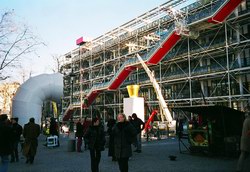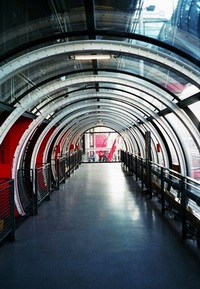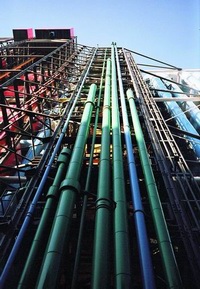Essay Question
Part I - World Heritage
The 30th Anniversary of the UNESCO "Convention" that established the World Heritage Center and its work to document cultural and natural landmarks throughout the world occurs at a critical moment in the evolution of the teaching of architecture. Consider the following:
-
The focus on social factors in design that was an outgrowth of the social activism of the 1960's and 1970's seems to have all but disappeared from the curriculum in schools of architecture.
-
The rise of importance in teaching architectural preservation of examples both monumental and simple in the 1980's and early 1990's has also receded.
-
The current interest with "green architecture" is in danger of becoming only that, a passing phase, as was the importance given to solar architecture twenty-five years ago.
-
The mainly Western and wasteful idea of "disposable" architecture or buildings designed for very short life spans is growing in popularity and being adopted around the globe.
-
Sculptural architecture designed in the same manner as "art for arts sake" has all but consumed the attention of most students.
To study architecture without full attention to what these issues mean is unfortunate. We are concerned about what is being neglected, that is, the vital relationships that exist between architecture and the social, cultural, and natural environment. These relationships serve people in their daily lives and transform architecture from the merely prosaic to something much more profound. This is both a theoretical and practical issue.
As an architect practicing in the 21st Century, you will encounter an ever-increasing number of projects that demand a sensitive response to what is already built. You will be asked in the interest of preservation how cultural sites of architectural significance should be adapted to new uses, and how new interventions should be designed that balance historical integrity with current human and environmental needs. You will need to understand these issues to design buildings in an imaginative... and socially responsible way.
The World Heritage Center roster of historic sites is evidence that what is built can be valued by generations. It reminds us that what is built may preserve the social values of a people and a place. These works, listed for their cultural heritage, are a challenge and inspiration to designers today to make buildings that are truly responsive to the social needs of people. The roster of World Heritage sites is a poignant reminder that too much of what is built today, and considered great architecture by many, does not meet these important social goals.
For architects to achieve the standards of socially-inspired design they will need to reconsider the conventional process by which today we make buildings. This is not an investigation into how buildings look, nor is it a discussion of who can build the biggest one. Places of lasting value usually reflect the desire on the part of the architect NOT to create a monument, but rather to create places for social good. The success is a product of how well these places serve people.
Building such places is not an impossible task, just a challenging one.
Part II - Pride of Place in Paris
"I should passionately like Paris to have a cultural center which would at once be museum and center of creation (centre de creation)"
President of the Republic, George Pompidou, 1969
Between 1972 and 1996 Marc Peitjean photographed each step of the architectural and sociological shock waves accompanying the construction of the Centre Georges Pompidou and the new Horloge district surrounding it.
From an advertisement for the book, Metro Rambuteau
The success of the Georges Pompidou Centre was as unexpected as it was instantaneous: twenty-five thousand visitors per day.
Paris Architecture, 1900-2000
 The images are as dramatic as the story of its development. A six-story, 90,000 square meter megastructure, with open floors 50 m by 170 m in size. A rectangular metal and glass box draped externally on the "street" side by brightly colored vertical ducts, elevator shafts and stairways; and on the other "entry" side, by a glazed escalator tube traveling diagonally up the face of the building. The whole, sitting on one side of a massive new plaza carved out of the traditional tightly packed Paris quartier of the Marais. The images are as dramatic as the story of its development. A six-story, 90,000 square meter megastructure, with open floors 50 m by 170 m in size. A rectangular metal and glass box draped externally on the "street" side by brightly colored vertical ducts, elevator shafts and stairways; and on the other "entry" side, by a glazed escalator tube traveling diagonally up the face of the building. The whole, sitting on one side of a massive new plaza carved out of the traditional tightly packed Paris quartier of the Marais.
The Centre National d'Art et de Culture Georges Pompidou, or as it is familiarly known, the Pompidou, houses the largest collection of modern art in the world (The National Museum of Modern Art); one of the largest public information libraries in France; conference and major performance spaces; children's play areas; two restaurants; and a roof-top terrace overlooking Paris. It draws anywhere from 8-9 million visitors per year.
The visitors are not all tourists. The library itself has a vast clientele: lines have formed to use the research facilities. Residents of the surrounding Beauborg district and beyond flock to the Place and its perimeter cafes to become part of the urban scene. The square itself has become a focus of official Paris activity. It is the site of gatherings, concerts, and all the kinds of impromptu social events that make up the life of a great city.
 Controversial at first due to the clash between the high-tech building and its classical 17th century neighborhood, thePompidou completed in 1978 quickly became an overwhelming popular success. Perhaps due in part to this success, the building program and the structure quickly became outdated. The building's galleries housing the Museum of Modern Art's permanent collection were remodeled as early as 1986. Controversial at first due to the clash between the high-tech building and its classical 17th century neighborhood, thePompidou completed in 1978 quickly became an overwhelming popular success. Perhaps due in part to this success, the building program and the structure quickly became outdated. The building's galleries housing the Museum of Modern Art's permanent collection were remodeled as early as 1986.
Just four years later, the Fodor's travel guide to Paris of 1990 describes a building, like many modern buildings, far down on its luck:
"…it has begun to show its age in no uncertain terms. The much-vaunted, gaudily painted service pipes that snake up the exterior - painted the same colors that were used to identify them on the architects' plans - need continual repainting. The plastic tubing that enclosed the exterior escalators are (sic) cracked and grimy. The skeletal supports in the interior are peeling and dirty."`
The entire building was completely retrofitted from 1992-2000. This massive new project re-distributed the interior spaces, provided new interior stairways and elevators, and renovated all of the exposed structure. The Centre Pompidouwas ready for the new Millenium. The two young architects who designed the Pompidou, Italian architect Renzo Piano and English architect Richard Rogers, faced a variety of challenges in creating this special place - and in re-designing it. Explicitly and implicitly, there were a variety of goals:
-
The creation of a new arts facility that would offer functions that would appeal to a variety of local and international patrons, including scholars, artists, and lay people seeking cultural events within a communal setting.
-
The desire to create a public place that would in some ways complement the public life associated with the nearby centuries-old Les Halles food market, which was recently removed to the outskirts of the city.
-
The need in the finished product to complement the cultural heritage of the unique public architecture of Paris.
-
The need to situate the building in a way that would serve as a Paris landmark for both local and foreign visitors.
-
The desire to identify the entire site as a public place and socially inviting, characteristic of the ubiquitous Frenchplace and public gardens of which there was numerous precedents in the rich architectural history of Paris.
-
The attempt to structure and style the building in such a way as to be innovative, responding to the primacy of innovation that is a hallmark of French art.
-
The reinforcement of the French spirit of the public's free access to culture in the building and its open spaces.
 The museum type has long been a major cultural event signifying the importance among the French of the arts as cultural patrimony. The transformation of the Palais du Louvre into a public museum starting at the time of the French Revolution is but one example of this particular society placing culture among its top priorities. It is interesting to note that the Centre Pompidou and the Place Georges-Pompidou were also a stunning success for then President of the French Republic, Georges Pompidou, who used the project to spur his vision of a grand, totally revitalized cultural landscape for Paris. The museum type has long been a major cultural event signifying the importance among the French of the arts as cultural patrimony. The transformation of the Palais du Louvre into a public museum starting at the time of the French Revolution is but one example of this particular society placing culture among its top priorities. It is interesting to note that the Centre Pompidou and the Place Georges-Pompidou were also a stunning success for then President of the French Republic, Georges Pompidou, who used the project to spur his vision of a grand, totally revitalized cultural landscape for Paris.
During the reign of his successor, Francois Mitterand, this vision would result in La Grande Arche; the new Opera; the completion of the Le Grand Louvre with the addition of thePyramid; the new public park, Science and Industry Museum, and Public Concert Hall (Le grand auditorium de la Cite de la musique) at La Villette; the Grande Galerie de l'Evolution at the National Museum of Natural History; and a variety of other public/private cultural landmarks. Culture is serious business in France.
It is to the credit of the designers that the Pompidou was not conceived as a merely a reflection of this deep regard for culture and pride of place by adopting some sort of recherche historic style or amalgam of styles for the design. Instead, the choice was made to create something completely new and of the age.
My own initial reaction to the Pompidou, which I first visited late in 1980 during a long sojurn in Paris, was at best, mixed (from my journals):
"...I drifted yesterday afternoon to the Centre Pompidou, probably this decade's most controversial building. It is certainly as bad as everyone says it is, and as good - unfortunately. It is an event, as the architects had wished and designed for, and thus is a brilliant tour-de-force. It is also ugly and out-of-place and has destroyed, inexorably destroyed the very fabric of a Paris district. It is that curious mixture of life and death that seems so natural to this city. Pairs is special, a place of a myriad of oppositions, a play on life...."
Ten days later, I wrote,
"...I spent the afternoon at the library at thePompidou, doing research. The place was mobbed. Crowds waiting just to get on the escalators, packs of people everywhere. The place easily sustains such scenes, more like a train station then a museum. Of course, this isn't a museum, is it? It is a Centre, an event, a happening. It works."
The Pompidou Centre as a place is an important example of a contemporary building respecting the cultural heritage of a particular people in a specific setting. It does this while simultaneously addressing the importance of the arts in all of the world's cultures. It is also maddingly confrontational as a work of architecture. Which is to say, it is a work of art that forces you to accept and process contradiction and chaos and make from it a new viable whole? And is this not the true definition of a social architecture?
Part III - Writing for the Public
In answering this year's Question, the Berkeley Prize Committee is particularly interested in responses that speak to the general public. If social architecture is to become the norm, rather then the exception, the PUBLIC must be persuaded of the value of design that reflects human worth. If social architecture is to be built, rather then simply discussed, the PUBLIC must be persuaded that there is added value to building buildings much different then most of the architecture being built today.
The idea of a social architecture is just that, a concept. Concepts often are seen as intricate or involved layers of thought that can only be explained by equally dense layers of writing and explanation. More and more today, architects utilize an intricate metalanguage to hide the fact they simply are unable to describe what they do and what they think should be done with any degree of simplicity and clarity.
Whether or not you feel that the Pompidou represents one of the best examples of social architecture or one of the best examples of the failures of contemporary design, neither position has the chance of becoming relevant until it resonates among all those who both build and use architecture. This includes the world at large, not just the relative few of us who are the denizens and products of the corridors of academia.
Writing that speaks only to academic jargon is at best understood by a select few. Writing that speaks to the general public is of a different sort altogether. It demonstrates the ability to synthesize ideas in a concise manner, to say and explain in as few words as possible highly complex and involved ideas. This does not mean the writing is necessarily simple or facile; it does mean that is understandable.
To be successful, such writing is also entertaining. Entertaining can be funny, it can also be serious. It is about engaging the reader, keeping the reader interested, and providing the reader with a "pay-off," an understanding in a new way something that previously was thought to be inexplicable or needing no other explanation or commentary. It is a small form of literature.
Your task, then, is different then writing an academic essay directed to your professor, your fellow student, or other members of the profession. It is about talking through the written word to your friends, your family, and acquaintances in other walks of life about subject matter with which they are unfamiliar.
This is also another reason why the work of the World Heritage Center is so exemplary: it identifies cultural sites that reflect a high consensus of social value to the public at large, not just to those immersed in architecture or environmental concerns. In formulating your response, you therefore may wish to consult the following United Nations web sites: UNESCO World Heritage; UN Year for Cultural Heritage; UN 1972 Convention.
There are other similar resources you might also want to consult. In the end the strength of your essay will come from a convincing argument that impresses not your colleagues, but those who do not normally think about these issues.
With the foregoing in mind, the Berkeley Prize Committee asks you to answer the following Question:
The Question:
When architects strive to create lasting monuments, some become part of the significant cultural heritage of our age. These successes seem to embody the most socially important values of a city, region, country, or even the world. Other attempts are only the reflection of the vanity of the designer or client and pass into oblivion. Worse, they become a permanent blight on the environment. As an architect, specifically, how can your work simultaneously embody the social values of one place, a particular culture, and universal human concerns?
|
|
|

Benjamin Clavan, AIA
|
|

 The images are as dramatic as the story of its development. A six-story, 90,000 square meter megastructure, with open floors 50 m by 170 m in size. A rectangular metal and glass box draped externally on the "street" side by brightly colored vertical ducts, elevator shafts and stairways; and on the other "entry" side, by a glazed escalator tube traveling diagonally up the face of the building. The whole, sitting on one side of a massive new plaza carved out of the traditional tightly packed Paris quartier of the Marais.
The images are as dramatic as the story of its development. A six-story, 90,000 square meter megastructure, with open floors 50 m by 170 m in size. A rectangular metal and glass box draped externally on the "street" side by brightly colored vertical ducts, elevator shafts and stairways; and on the other "entry" side, by a glazed escalator tube traveling diagonally up the face of the building. The whole, sitting on one side of a massive new plaza carved out of the traditional tightly packed Paris quartier of the Marais.  Controversial at first due to the clash between the high-tech building and its classical 17th century neighborhood, thePompidou completed in 1978 quickly became an overwhelming popular success. Perhaps due in part to this success, the building program and the structure quickly became outdated. The building's galleries housing the Museum of Modern Art's permanent collection were remodeled as early as 1986.
Controversial at first due to the clash between the high-tech building and its classical 17th century neighborhood, thePompidou completed in 1978 quickly became an overwhelming popular success. Perhaps due in part to this success, the building program and the structure quickly became outdated. The building's galleries housing the Museum of Modern Art's permanent collection were remodeled as early as 1986.  The museum type has long been a major cultural event signifying the importance among the French of the arts as cultural patrimony. The transformation of the Palais du Louvre into a public museum starting at the time of the French Revolution is but one example of this particular society placing culture among its top priorities. It is interesting to note that the Centre Pompidou and the Place Georges-Pompidou were also a stunning success for then President of the French Republic, Georges Pompidou, who used the project to spur his vision of a grand, totally revitalized cultural landscape for Paris.
The museum type has long been a major cultural event signifying the importance among the French of the arts as cultural patrimony. The transformation of the Palais du Louvre into a public museum starting at the time of the French Revolution is but one example of this particular society placing culture among its top priorities. It is interesting to note that the Centre Pompidou and the Place Georges-Pompidou were also a stunning success for then President of the French Republic, Georges Pompidou, who used the project to spur his vision of a grand, totally revitalized cultural landscape for Paris. 